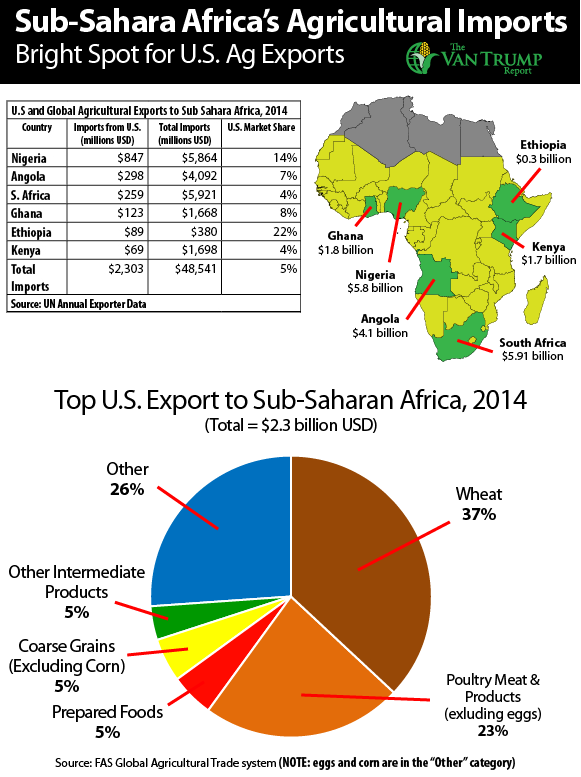 With little in the headlines regarding U.S. crop production, I thought it would be interesting to take a look a the explosive growth in Sub-Saharan Africa. Essentially the area we are talking about includes all of the African continent which lies south of the Sahara Desert. It does not include the five predominantly Arab states of northern Africa which consists of Morocco, Algeria, Tunisia, Libya, Egypt and the Sudan. Keep in mind Sub-Saharan Africa, especially East Africa, is regarded by some geneticists as being the birthplace of the human race (the genus Homo). Stone tools are first attested around 2.6 million years ago, when H. habilis in Eastern Africa used so-called pebble tools: choppers made out of round pebbles that had been split by simple strikes. This marks the beginning of the Paleolithic, or Old Stone Age; its also argued to be where the last ice age ended, around 10,000 years ago. In any regard, this area of the world has seen a rising appetite for imported agricultural goods, a direct result of the region’s robust growth in gross domestic product (GDP) and population. The USDA recently estimated Sub-Saharan Africa imported close to $50 billion in food and agricultural products, a value that has been growing rapidly for the last two decades. In comparison, India only imported around $20 billion in agricultural products and they have 300 million more people. While U.S. exports to Sub-Saharan Africa have slowed recently, several key U.S. exports continue to thrive, laying a roadmap for future success in the region. It’s worth noting that Sub-Saharan Africa’s GDP has grown by a whopping +60% and its middle class has expanded by +90% in just the past 10 years. In fact many sources now regard this as one of the fastest growing regions in the world, perhaps more robust than Southern Asia. Overall, consumer-oriented products have seen the highest growth. The brightest star has been U.S. poultry exports. In fact, Sub-Saharan Africa was recently the third-largest market for U.S. poultry and has experienced 30% year-on-year growth for the last five years. In addition, U.S. exports of prepared foods, condiments/sauces, and dairy products have all seen strong growth in the last five years. Another success story has been U.S. wheat exports. Sub-Saharan Africa has long been the top destination for U.S. wheat exports and will likely continue to be a significant market. While Nigeria has traditionally accounted for the majority of U.S. wheat exports to the region, other countries in West and East Africa have seen strong growth. Bottom-line, most all economist and forecasters believe U.S. producers will continue to enjoy large export growth opportunities for the next several years. (Read more at USDA/FAS)
With little in the headlines regarding U.S. crop production, I thought it would be interesting to take a look a the explosive growth in Sub-Saharan Africa. Essentially the area we are talking about includes all of the African continent which lies south of the Sahara Desert. It does not include the five predominantly Arab states of northern Africa which consists of Morocco, Algeria, Tunisia, Libya, Egypt and the Sudan. Keep in mind Sub-Saharan Africa, especially East Africa, is regarded by some geneticists as being the birthplace of the human race (the genus Homo). Stone tools are first attested around 2.6 million years ago, when H. habilis in Eastern Africa used so-called pebble tools: choppers made out of round pebbles that had been split by simple strikes. This marks the beginning of the Paleolithic, or Old Stone Age; its also argued to be where the last ice age ended, around 10,000 years ago. In any regard, this area of the world has seen a rising appetite for imported agricultural goods, a direct result of the region’s robust growth in gross domestic product (GDP) and population. The USDA recently estimated Sub-Saharan Africa imported close to $50 billion in food and agricultural products, a value that has been growing rapidly for the last two decades. In comparison, India only imported around $20 billion in agricultural products and they have 300 million more people. While U.S. exports to Sub-Saharan Africa have slowed recently, several key U.S. exports continue to thrive, laying a roadmap for future success in the region. It’s worth noting that Sub-Saharan Africa’s GDP has grown by a whopping +60% and its middle class has expanded by +90% in just the past 10 years. In fact many sources now regard this as one of the fastest growing regions in the world, perhaps more robust than Southern Asia. Overall, consumer-oriented products have seen the highest growth. The brightest star has been U.S. poultry exports. In fact, Sub-Saharan Africa was recently the third-largest market for U.S. poultry and has experienced 30% year-on-year growth for the last five years. In addition, U.S. exports of prepared foods, condiments/sauces, and dairy products have all seen strong growth in the last five years. Another success story has been U.S. wheat exports. Sub-Saharan Africa has long been the top destination for U.S. wheat exports and will likely continue to be a significant market. While Nigeria has traditionally accounted for the majority of U.S. wheat exports to the region, other countries in West and East Africa have seen strong growth. Bottom-line, most all economist and forecasters believe U.S. producers will continue to enjoy large export growth opportunities for the next several years. (Read more at USDA/FAS)